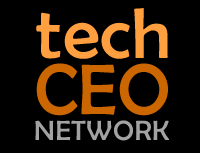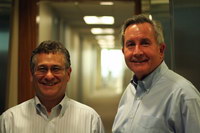Thursday, October 14, 2010
Interview with Richard Koffler and John Morris, The Tech CEO Network

Looking to bridge the gap between the immense amount of technology created at local universities and the commercial market, a new group--the Tech CEO Network (www.techceonetwork.com)--has quietly been working in Los Angeles to try to help spin out new companies from institutions like UCLA, Caltech, USC, UCSB, and other colleges and universities in town. The group--which was started by Richard Koffler and John Morris, two well known investors in Los Angeles--has been trying to help connect CEOs with interesting university and other technology projects. To better understand what they're trying to do, we spoke with both Richard and John about the group.
Thanks for the time today. What is the idea behind the Tech CEO Network?

John Morris: The whole idea is to help inventors, particularly but not limited to inventors at local universities, recruit qualified CEOs to their team. We're looking for inventors interested in commercializing and spinning out their technology into a company. Many universities and inventors may not have the know-how to launch a successful business, and there are very few places to go to gain this know-how. The Tech CEO Network is there to fill the gap. We've initially focused on university-based research groups, and as we've gotten up and running, we've found that there's no need to limit it to just universities. We're a group of people who are interested in this, have been-there, done-that, and are not consultants, and not fundraisers. We're just people giving enormously of our time to a situation, where we can join a startup team as a co-founder, to help them successfully spin out, launch, and commercialize their technology.
Richard Koffler: If you look at the universities, they more or less operate at one of two extremes. They either know how to license technology to a medium or large company, or at the other extreme, know how to handle and inventor who is a researcher who goes out and wants to spin out their company, because they have some entrepreneurial spirit and want to go out on their own. Universities have a bunch of companies on either side that have done that. But, in fact, that is a minority of the projects. There are a bunch of projects that are in the middle, where there is currently no model. If an existing company is not interested in licensing, and a researcher is not an entrepreneurial spirit, those projects go no where. What we are doing, is we are coming in and saying that there is a model here, and can help bring someone in--not as a mentor or coach, but as a hands-on-CEO, who is interested in getting involved in the business, full-in, not just with coaching and mentoring advice, but interested in taking their technology to market, with the researcher, with the inventor.
Where is this talent coming from?
Richard Koffler: That is one of the tasks we have as a group. We have to find a good bench of interested CEOs--interested, and qualified CEOs--so that there is a good probability that a project will find a CEO. I might be jumping ahead, but what we are finding so far is success. Myself, I am now working with a medical ultrasound technology firm, working directly with the researcher and a design firm. That technology is coming out of USC's biomedical department, which is part of its School of Engineering. Last week, John and I met with Dina Lozofsky, now at U.C. Santa Barbara, who sent us a couple of projects she has found, and we're already gotten one of our group going up to look at that technology, because our member has very relevant experience in this area, and has determined that the technology is valuable. We don't know if that will go beyond this point, but we now have 10 to 12 people in the group. We're finding those relationships, even though our bench is small right now.
What do you see is missing most from these technology projects from inventors and universities?
John Morris: I think it's trying to make a decent connection with customers, and trying to assess the size and viability of the market. It's trying to determine if there is a viable way to go to market, and also deal with competitive issues. It's really trying to make sense of who is the customer, how do we get to them, how big is the market. Ultimately, once those issues are validated, it's how to go about building the product, recruiting talent, and enough capital to make it into a business. A lot of the time, all the startup and inventor can get their head around is the technology, much less trying to deal with business issues. That's why we're hoping that bringing domain expertise and an industry network will help facilitate that process.
It looks like you're already getting into working with Universities on projects. We've heard this can be difficult, sometimes. How has that gone for you?
Richard Koffler: I'm involved hands-on, on three projects right now. Universities are actually very eager to license technology, and they understand the older model where you have an existing company at the table, and licensing things. The negotiations there usually revolve around economics. That is a process that works well, and universities understand that, and they don't have any problems or questions about how to get that done.
On the other side of that, although universities had not been very experienced with spinouts, where the researcher is also a person active as an entrepreneurial, active member of the team, although there is some back and forth, and universities have gotten hung up on price tags and terms--one by one, everyone has figured that out.
The third situation is the middle ground--where a startup needs to be formed, but there is no company there yet. It's where someone is still figuring out what the initial steps are to transform research into a viable company, which is where things get confusing. The reason for this, is because, unlike with a licensing deal with an existing company, there is still lots of risk and time to figure out if it's worth licensing. And, compared with the other extreme, where a researcher is spinning out a company, in this case a researcher is not going anywhere, and is staying at whatever university department they are in. It's that in-between situation where people aren't sure how to license technology, without big checks and contracts--where that startup is not yet ready for them.
How long has your group been working on this?
John Morris: It's probably been a little more than a year in its present shape, although we've been patient because we have no budget. It's not a big organization, there's no sponsor, and we're not making any money on this. Instead, we're talking to various groups at the university level, and building up awareness of what we're doing. We have a very dedicated group of founding members, and we've so far had around four to five meetings. We've assigned each member of the group to monitor and maintain connectivity with the various constituents. When you think about it, working with the universities, it's not just talking with UCLA; it's talking with their engineering school, their medical school, their office of intellectual property. At USC, there's probably five or six different touchpoints. Caltech is a bit easier, but there are quite a number of touchpoints overall who we've had to keep in contact with, remind them who we are, and that we're waiting to hear from them about potential projects.
Is there any ideal kind of project or research you'd like to work with as a group?
Richard Koffler: There are three criteria. One, is there needs to be a path to commercialization. Second, we need not just the invention, but we need the inventor to come along with it to help us, because there's lots of work on the back end of this to refine this so that it can be a product, and not just a research project. We need to be able to determine a pathway to a revenue generating product. The last piece, is the inventor should not expect to be CEO--and if fact, it's likely the inventor will not be CEO. An example might help: We were recently presented with a project, and two of our members jumped at a chance to look at it, thinking they could become CEO. The technology was ready for revenue, and the product was refined. But, the researcher didn't want to add a CEO, was very adamant that they wanted to be CEO, and all they were really interested in, actually, was getting a term sheet. In fact, they didn't even need that, they could launch with what they had. Needless to say, they did not go anywhere with our group. There were no hard feelings, it was just not a match.
John Morris: The challenge is, we're a fairly small group, and not everything from a university is going to work. Not every technology sent to us will have a proper match, and we've got to be thoughtful about the process. It's somewhat a game of numbers, however, in that we need to see enough deal flow and opportunities that we can encourage our members to stay engaged, and so that we have enough success doing this that our constituents continue sending us stuff. The challenge is, there is quite a lot of esoteric research out there which will never be good enough to start a company.
If there's a measure of the success of the group, what would that be?
John Morris: Over the next two or three years, if we're successful, we'll get five or six companies up and running with members of our team. That means, with probably around fifteen members of our group right now, we'd only expect about 1/3 of them to be successful. But, once we get that interaction going, we start believing in ourselves, investor groups will learn about us. We're just trying to create more companies in Los Angeles, and to be involved with them. I think if we can start six companies, that would be thrilling.
Thanks, and good luck!